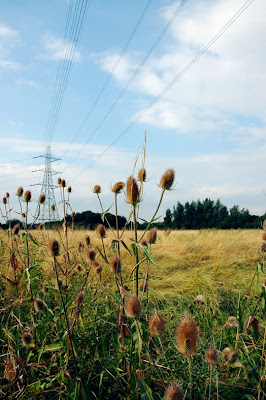Hackney Marshes, our legacy

Our little bit of countryside... and the pylons are gone now

Riverside art!

A barge with a view!

A missing bus under the A12... did it fall off the flyover?
Living on the doorstep of Hackney Marshes, we spend a lot of time here with the kids, cycling, walking, collecting blackberries, playing, drawing and even golfing. We feel lucky to have this fantastic green space as our playground, our little piece of countryside so close to Central London. Meandering around it's pathways we often see herons, kingfishers, swans and rabbits who live in the wild woodlands and fields that border the River Lea. In contrast we marvel at brilliantly expressive graffiti art, the embellished carcass of a burnt out bus and the weathered barges of the river dwellers that line the route eastwards towards the Olympic site. Hackney Marshes, famous for it's football pitches, is used by so many; as a scenic cycle route to work, to walk the dog, for sport and exercise, for children to run, explore and play, for picnics, horse riding, as a canvas, for thought and reflection and so much more...
Is all of this about to change? Will it be cleaned up, landscaped, chopped down, sterilised. Will it's art (and soul) be eradicated, it's wildness tamed and it's footballers banished - so that the world can see a superficially cleaned up, refurbished, world-class London for those few weeks in 2012?
I soooo hope not! The legacy I want from the Olympics is that the Marshes are left wild and unmanicured and that the creativity, indicative of our vibrant corner of London, remains a testament to it's unique artistic edge and isn't just scrubbed away. I hope that it's history isn't erased and that people who use the Marshes are not pushed away – that the river remains a home and habitat to all it's residents. This haven, a jewel in the crowded, urban chaos of Hackney, is a priceless antidote to city life, coveted and loved by it's people.
As we look forward to the big event we'll continue to ride the riverside route, cycling past the transformed Leebank Square and the decaying Lesney's Matchbox factory, to the 11 mile gaza-esque perimeter wall of the Olympic site to record how the landscape evolves.

Comments
Post a Comment